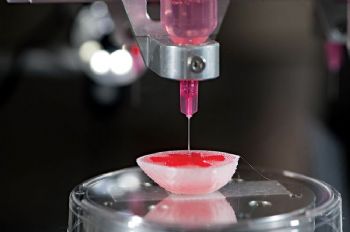
A team of researchers from Carnegie Mellon University (in Pittsburgh, Pennsylvania) has published a paper in Science on a new technique that “allows anyone to 3-D bio-print tissue scaffolds out of collagen — the major structural protein in the human body”.
The researchers say this first-of-its-kind method brings the field of tissue engineering one step closer to being able to 3-D print a full-size adult human heart.
The technique, known as Freeform Reversible Embedding of Suspended Hydrogels (FRESH), has allowed the researchers to overcome many challenges associated with existing 3-D bio-printing methods, while achieving “unprecedented resolution and fidelity, using soft and living materials”.
Each of the organs in the human body, including the heart, is built from specialised cells that are held together by a biological scaffold called the extracellular matrix (ECM); this provides the structure and the biochemical signals that cells need to carry out their normal function.
However, it has not been possible until now to rebuild this complex ECM architecture using traditional bio-fabrication methods.
Adam Feinberg, whose laboratory performed this work, said: “What we have shown is that we can print pieces of the heart out of cells and collagen into parts that truly function, like a heart valve or a small beating ventricle.
“By using the MRI data of a human heart, we were able to accurately reproduce patient-specific anat-omical structures and 3-D bio-print collagen and human heart cells.”
Mr Feinberg says the need for replacement organs is immense, and new approaches are needed to engineer artificial organs that can repair, supplement or replace organs.
He adds that FRESH has applications in many aspects of regenerative medicine, from wound repair to organ bio-engineering.
“What we are talking about is the convergence of technologies — not just what my lab does in bio-printing, but also other labs and small companies in the areas of stem cell science, machine learning and computer simulation, as well as new 3-D bio-printing hardware and software.
“It is important to understand that there are many years of research yet to be done, but there should still be excitement that we are making real progress towards engineering functional human tissues and organs.”
A video relating to FRESH can be found at the Web site (
www.cmu.edu/news/stories/archives/2019/august/3d-printing-heart-tissue.html).